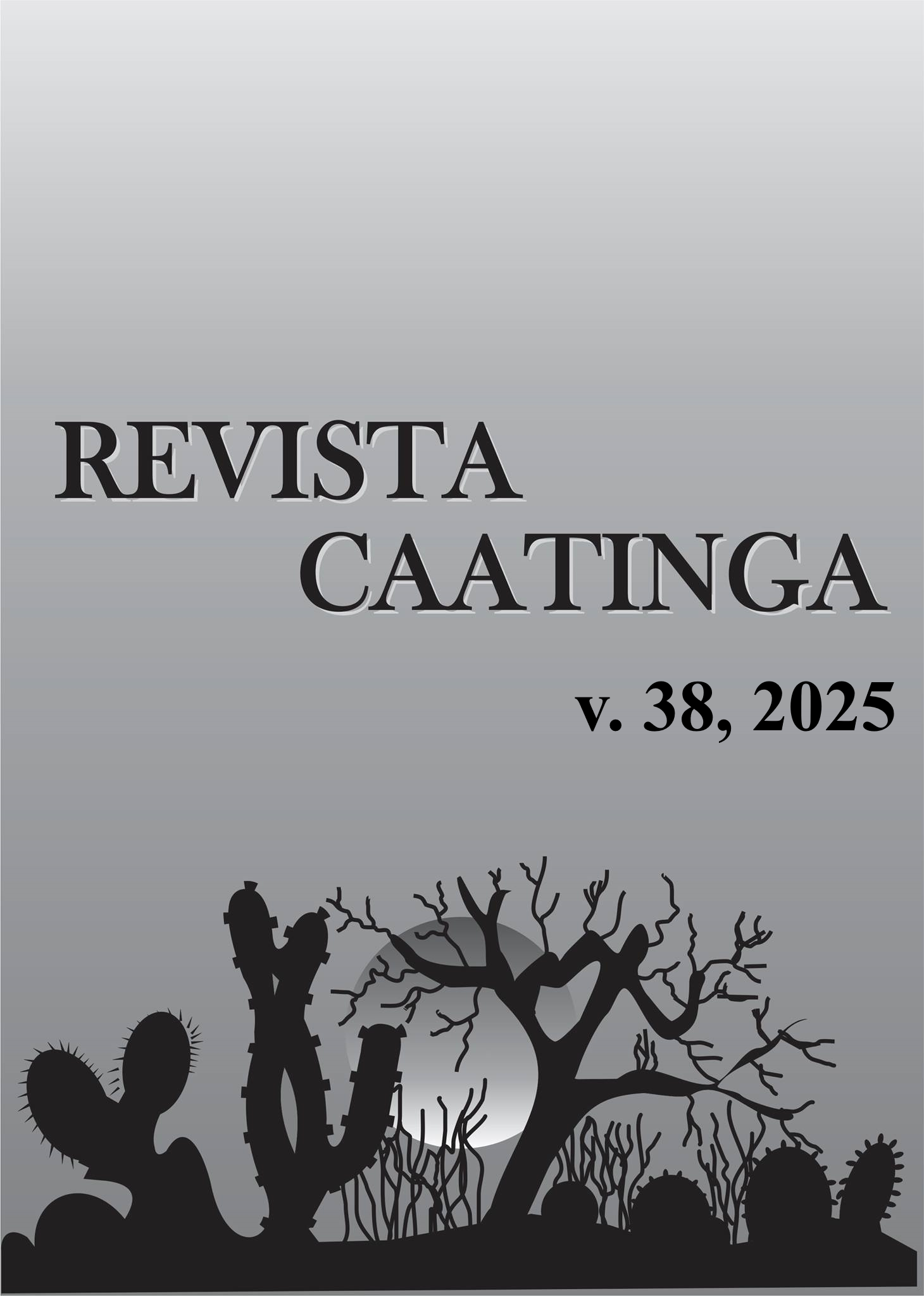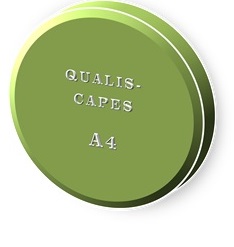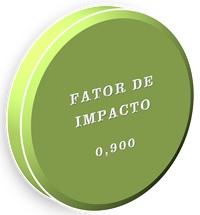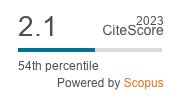Growth of cotton irrigated with wastewater and under organic fertilization
DOI:
https://doi.org/10.1590/1983-21252025v3812808rcKeywords:
Gossypium hirsutum L. Water reuse. Goat manure. Fish farming. ‘BRS 416’.Abstract
The objective of this work was to determine the potential use of fish farming effluent associated with organic fertilization for the growth of ‘BRS 416’ cotton. The experiment was carried out in a greenhouse at the Center for Agrarian Sciences of the Federal Rural University of the Semi-Arid Region (UFERSA), Mossoró, RN, Brazil, in a randomized block design, with a 5 × 5 factorial scheme and four replicates. Treatments included mixtures of fish farming effluent and public-supply water (0, 25, 50, 75, and 100% effluent) and five concentrations of goat manure (0, 5, 10, 15, and 20% based on soil volume). Plant height, stem diameter, number of leaves, root length, leaf area, leaf dry mass, root dry mass, stem dry mass and total dry mass were evaluated. The use of substrate with 20% goat manure irrigated with dilution D4 (75% FFE and 25% PSW) favored the performance of the variables PH, SD, NL, RL, LA, LDM, RDM, SDM and TDM of ‘BRS 416’ cotton plants. Reuse of the fish farming effluent D5 (100% FFE), with electrical conductivity of 3.59 dS m-1, is an alternative that favors the growth and biomass production of ‘BRS 416’ cotton plants.
Downloads
References
ALBANO, F. G. et al. New substrate containing agroindustrial carnauba residue for production of papaya under foliar fertilization. Revista Brasileira de Engenharia Agrícola e Ambiental, 21: 128-133, 2017.
ALMEIDA, R. O. P. O.; SÁNCHEZ, L. E. Indicadores da Qualidade do Substrato para Monitoramento de Áreas de Mineração Revegetadas. Floresta e Ambiente, 22: 153-163, 2015.
ALVARES, C. A. et al. Köppen’s climate classification map for Brazil. Meteorologische Zeitschrift, 22: 711-728, 2013.
AMORIM, D. J. et al. Multidimensional analysis associated with growth analysis in the selection of organic substrates for the production of tomato seedlings. Journal of Agricultural Science, 10: 326-336, 2018.
AQUINO, C. F. et al. Uso de água residuária da piscicultura no crescimento de mudas de maracujazeiro-amarelo. Revista de Educação, Ciência e Tecnologia de Almenara / MG, 5: 58-74, 2023.
ARAÚJO, A. F. B. et al. Fiber Quality, Yield, and Profitability of Cotton in Response to Supplemental Irrigation with Treated Wastewater and NPK Fertilization. Agronomy, 12: 1-16, 2022.
AYERS, R. S.; WESTCOT, D. W. A qualidade da água na agricultura. 2. ed. Campina Grande: UFBP, 1999. (Estudos da FAO. Irrigação e Drenagem, 29).
BARBOSA, J. L. et al. Crescimento de algodoeiro colorido cv. BRS Topázio em solos com distintas salinidades e adubação orgânica. Revista de Ciências Agrárias, 42: 206-213, 2019.
EMBRAPA - Empresa Brasileira de Pesquisa Agropecuária. Manual de métodos de análise de solo. 2. ed. Rio de Janeiro, RJ: Centro Nacional de Pesquisa de Solos, 1997. 212 p.
EMBRAPA - Empresa Brasileira de Pesquisa Agropecuária. Sistema brasileiro de classificação de solos. 3. ed. Rio de Janeiro, RJ: Embrapa Solos, 2013. 353 p.
EMBRAPA - Empresa Brasileira de Pesquisa Agropecuária. Soluções tecnológicas. Available at: https://www.embrapa.br/busca-de-solucoes-tecnologicas/-/produto-servico/5492/algodao-branco---brs-416. Access on: Aug. 13, 2022.
FERNANDES, M. M.; MACIEL, J. R. Potencial adaptativo de Melocactus violaceus Pfeiff (Cactaceae) para solos argilosos. Hoehnea, 50: e582021, 2023.
FERREIRA, D. F. SISVAR: A computer analysis system to fixed effects split plot type designs. Revista Brasileira de Biometria, 37: 529-535, 2019.
FERREIRA, M. M. et al. Crescimento e produtividade do algodoeiro herbáceo submetid à adubação orgânica. Revista Brasileira de Agropecuária Sustentável, 8: 52 - 61, 2018.
FRUSCELLA, L. et al. Investigating the effects of fish effluents as organic fertilisers on onion (Allium cepa) yield, soil nutrients, and soil microbiome. Scientia Horticulturae, 321: 112-297, 2023.
GOMES, I. H. et al. Selection of cotton genotypes for yield and fiber quality under water stress. Revista Brasileira de Engenharia Agrícola e Ambiental, 26: 610-617, 2022.
GRIMES, D. W.; CARTER, L. M. A Linear rule for direct nondestructive leaf area measurements. Agronomy Journal, 61: 77-479, 1969.
MELAKU, S.; NATARAJAN, P. Status of integrated aquaculture-Agriculture systems in Africa. International Journal of Fisheries and Aquatic Studies, 7: 263-269, 2019.
NASCIMENTO, M. I. S. S. et al. Insights two main products from the goat wine culture in the Brasilian Northeast, Research, Society and Development, 11: 1-13, 2022.
NASCIMENTO, T. S. et al. Irrigação com efluente de piscicultura no cultivo de mudas de tomate. Revista Brasileira de Agricultura Irrigada, 10: 866-874, 2016.
NUNES, A. J. P. Tratamentos de efluentes e recirculação de água na engorda de camarão marinho. Revista Panorama da Aquicultura, 12: 27-39, 2002.
POUR, A. P.; FARAHBAKHSH, H.; TOHIDINEJAD, E. Nitrogen, phosphorous and potassium levels affected growth indices, leaf gas exchange parameters and biomass production of henna (Lawsonia inermis L.) ecotypes. Industrial Crops and Products, 163: 113-297, 2021.
RICHARDS, L. A. Diagnosis and improvement of saline and alkali soils. USDA Handbook, 60. Washington D. C. U.S. Salinity Laboratory. 1954. 160 p.
ROSA, D. K. O. F. et al. Aproveitamento do resíduo de tanque de piscicultura na produção de mudas de mamoeiro em Rorainópolis. Ambiente: Gestão e Desenvolvimento, 11: 120-136, 2018.
SILVA NETA, A. M. S. et al. Fitomassas e qualidade de mudas de maracujazeiro--azedo sob irrigação com águas salinas e adubação nitrogenada. Revista de Ciências Agrárias, 45: 63-73, 2022.
SILVA, A. A. D. et al. Cherry tomato production and seed vigor under irrigation with saline effluent from fish farming. Revista Brasileira de Engenharia Agrícola e Ambiental, 25: 380-385, 2021.
SILVA, F. A. et al. Pyruvic acid as attenuator of water deficit in cotton plants varying the phenological stage. Brazilian Journal of Biology, 83: 272-280, 2023.
SOUZA, J. I. R. et al. Uso de água residuária da piscicultura na produção de plantas nativas da caatinga. Jornada de Iniciação Científica e Extensão, 15: 1-2, 2020.
TAIZ, L. et al. Fisiologia e desenvolvimento vegetal. 6. ed. Porto Alegre, RS: Artmed, 2017. 858 p.
ZHANG, J. et al. Evaluation of saline water irrigation on cotton growth and yield using the AquaCrop crop simulation model. Agricultural Water Management, 261: 107-355, 2022.
Downloads
Published
Issue
Section
License
Os Autores que publicam na Revista Caatinga concordam com os seguintes termos:
a) Os Autores mantêm os direitos autorais e concedem à revista o direito de primeira publicação, com o trabalho simultaneamente licenciado sob a Licença Creative Commons do tipo atribuição CC-BY, para todo o conteúdo do periódico, exceto onde estiver identificado, que permite o compartilhamento do trabalho com reconhecimento da autoria e publicação inicial nesta revista, sem fins comerciais.
b) Os Autores têm autorização para distribuição não-exclusiva da versão do trabalho publicada nesta revista (ex.: publicar em repositório institucional ou como capítulo de livro), com reconhecimento de autoria e publicação inicial nesta revista.
c) Os Autores têm permissão e são estimulados a publicar e distribuir seu trabalho online (ex.: em repositórios institucionais ou na sua página pessoal) a qualquer ponto antes ou durante o processo editorial, já que isso pode gerar alterações produtivas, bem como aumentar o impacto e a citação do trabalho publicado (Veja O Efeito do Acesso Livre).







